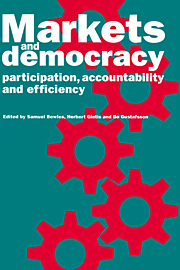Book contents
- Frontmatter
- Contents
- List of figures
- List of tables
- Preface
- 1 Post-Walrasian political economy
- Part I Agency, incentives, and democratic accountability
- Part II Institutions and institutional change
- 4 Toward a framework for analyzing institutions and institutional change
- 5 Imperfect choice and rule-governed behavior
- 6 Organizational equilibria and institutional stability
- 7 Agency problems and the future of comparative systems' theory
- Part III Conditions for the success of the democratic firm
- Part IV Productivity, distribution, and power
- Part V Ownership, participation and capital markets
- Part VI Political democracy and economic democracy
- Bibliography
- Author index
- Subject index
6 - Organizational equilibria and institutional stability
Published online by Cambridge University Press: 05 March 2012
- Frontmatter
- Contents
- List of figures
- List of tables
- Preface
- 1 Post-Walrasian political economy
- Part I Agency, incentives, and democratic accountability
- Part II Institutions and institutional change
- 4 Toward a framework for analyzing institutions and institutional change
- 5 Imperfect choice and rule-governed behavior
- 6 Organizational equilibria and institutional stability
- 7 Agency problems and the future of comparative systems' theory
- Part III Conditions for the success of the democratic firm
- Part IV Productivity, distribution, and power
- Part V Ownership, participation and capital markets
- Part VI Political democracy and economic democracy
- Bibliography
- Author index
- Subject index
Summary
Introduction
In the New Institutional economics firm ownership or its governance system is endogenously and efficiently determined by the characteristics of the resources which are used in the organization: namely their degree of specificity and their monitoring requirements. Section 2 of this chapter summarizes the New Institutional view. Section 3 inverts the New Institutional view by arguing that the characteristics of the resources, employed in the firm are, in turn, determined by the nature of its ownership and/or governance system. This view supports some of the claims of the Radical economists who have traditionally argued that the technology and the internal organization of the firm are often not due to the need for increasing efficiency and can be better explained as an outcome of given property relations. The two arguments are integrated by introducing the concept of property rights and technological equilibria and, more generally, the concept of organizational equilibria. In section 4 these equilibrium concepts are developed by means of a simple model. There, we argue that institutionally stable property rights' equilibria need not be efficient. In section 5 we consider Williamson's contracting scheme and suggest two ways in which the scheme can be generalized. Finally, in the concluding section 6 we apply briefly the framework developed in this chapter to two issues. The first concerns the diversity of institutions which characterized the major Western capitalist countries after 1945 in spite of their different efficiency. The second is related to the possible inability of democratic institutions to come about in spite of their greater efficiency.
- Type
- Chapter
- Information
- Markets and DemocracyParticipation, Accountability and Efficiency, pp. 86 - 115Publisher: Cambridge University PressPrint publication year: 1993
- 13
- Cited by



